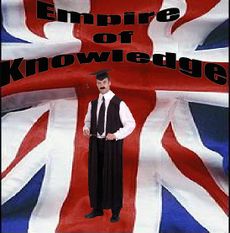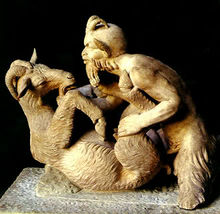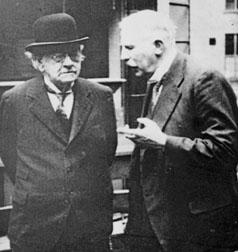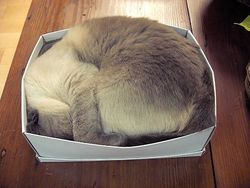The History of the Atom
The History of the Atom was first published by His Majesty's Stationery Office in 1948 as part of the post-war Empire of Knowledge series, aimed at equipping young boys with the skills required to go out into the world and oppress native peoples. As the "Empire of Knowledge" series was printed under the Austerity Government paper was still rationed and the books were necessarily a greatly abridged version of the sum of human knowledge.
Early Man
Our ancient ancestors did not much concern themselves with questions of from what the world was made, preferring to spend their days to exploring the possibilities of banging rocks together, sharpening them and using these to discover what animals are made from. However, a remarkable flowering of Philosophy in classical Greece changed all that. Suddenly learned men were prepared to spend time considering the very structure of the universe, possibly because ancient Hellenic culture offered few alternatives to un-athletic men without an unhealthy interest in goats.
One of the leading thinkers of the day, Democritus, developed a thought-experiment in which famously imagined some cheese - a major step forward for the dairy industry. He extended this theorem by imagining cutting the cheese in half and in half again, repetitive manual-tasks being very soothing for the severely autistic. Eventually, Democritus supposed, one would be left with a tiny particle of cheese so small as to be uncutable. He named this supposed particle "A Tomos" after the Welsh philosopher who had been his teacher.
The ancient world was not yet ready for such innovations, preferring to hold to the more credible idea that the universe consisted of concentric, unseeable and untouchable glass spheres. As this opinion was endorsed by Aristotle, who was widely revered following his marriage to Jackie Kennedy, atomic theory was dismissed for more than a millennium.
England takes the lead
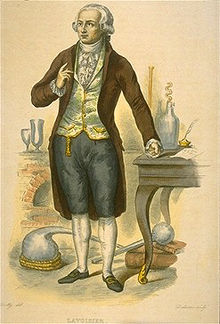
The world had largely forgotten about atoms until the eighteenth century when aristocrat and scientist, Antoine Lavoisier, had the novel idea of testing theories by experiment. He soon found that the world could not be made of concentric glass spheres by firing hammers into the air. No matter the altitude attained no shards of broken glass ever harmed the peasants he had stationed below.
Encouraged by this success, Lavoisier continued his work, proving that the masses of reacting chemicals remained unchanged, even after their re-combination into new substances. The world at large treated this news with indifference but in Revolutionary France it excited the chairman of the "Committee of Public Safety" (Commité de salut public) enough to order Lavoisier's head removed by guillotine. Further progress from Lavoisier in the field of Chemistry was brief and incoherent. Meanwhile in England, John Dalton, a true colossus of British Science, was commencing his studies. Within a few years he would prove the existence of atoms beyond doubt.
It is thought unlikely that John Dalton knew of Lavoisier's work. Being a stout Briton, Dalton was not given to faith in outlandish, foreign notions, and Lavoisier had committed his discoveries to paper only in an impenetrable code which we these days call French. Dalton experimented in splendid isolation, not only confirming the reality of atoms, but producing the world's first Periodic Table of Elements in 1808. Dalton's table contained only the 20 elements known at the time, though the pragmatic Dalton was prepared to admit that;
| “ | There may be others in filthier climes, though these score be the elements required to make an Englishman. | ” |
Dalton's list was a landmark in science despite including substances that we would no longer think of as elements, such as tea and repressed rage.
In 1811 Amadeo Avogadro attended a concert by Scottish scientist and amateur conjurer "The Great McPrendo" at La Scala, Milan. As part of his mind-reading act McPrendo asked the Italian to "Think of a number - any number". Avogadro thought for some moments and gave his considered reply "6.022 141 79 x 1023". McPrendo immediately realised the significance of the answer, it being large enough and sufficiently difficult to understand to serve as the number of particles in a mole of any substance. It is testament to McPrendo's magnanimity that he gave credit for this discovery to Avogadro rather than claim it himself. McPrendo rushed home to Britain to publish, leaving the bemused Avogadro to return to tending his pastrami farm.
Inside the atom
By 1897 J.J. Thomson had discovered electrons and claimed them for Queen Victoria. At the time it was believed that atoms were manufactured in Switzerland and were, therefore, neutral. Aware that electrons were deeply negative and yet were emitted by atoms, Thomson postulated that atoms themselves were actually positive and that the electrons were scattered throughout them like raisins in a Garibaldi. He, therefore, called his new atomic structure - "The Plum Pudding Model". Thomson's genius was widely celebrated around the Empire; in recognition he was awarded a pension from the government and several small African nations to exploit as he saw fit.
Unlike aristocratic Lavoisier and independently wealthy men such as Dalton and Thomson, Ernest Rutherford's birth seemed to count against his becoming a scientist. Born poor to a Kiwi family, Rutherford was kindly raised by humans and showed great aptitude at school despite the disadvantages of a long beak and fore-shortened front limbs. The handicap that seemed most likely to preclude Rutherford from a career in Science was foreign-ness, as he had been born in New Zealand - a distant colony used to house re-offenders from the prison colonies of Botany Bay and often compared to Wales in Spring (but without the laughter). English he may not have been, but English-speaking he was. With dogged determination unexpected in someone from so far overseas, Rutherford set out to Cambridge in 1895 where, after much difficulty, he gained an interview at the Cavendish Laboratories, the leading institute of research Physics. J.J. Thomson himself conducted the interview as he did not wish to subject any of his staff to risk of contamination by antipodean infection. To the great benefit of mankind, Thomson discovered an unexpected ability for wicket-keeping within this unlikely applicant and within days Rutherford had started work.
One night, when he had cleared the laboratories of the regurgitated stomach-contents of high-spirited undergraduates, Rutherford wandered the corridors wandering what it would be like to be able to lay down his janitorial duties and become a scientist. As luck would have it, one of the laboratory doors had been left ajar and young Ernest seized his opportunity, swiftly bombarding some handy Gold leaf with dominant alpha-particles left in a bucket at the back of the lab. The results astounded everyone.
Without knowing how, Ernest Rutherford had shown that atoms were mostly empty space (like Canada) since the alpha-particles generally passed through them un-deflected. Rutherford decided that he had proved the existence of the nucleus before recalling his position in society and returning to toilet-scrubbing duties.
Johnny Foreigner has a bash
There wasn't much time for Physics in 1914, what with those spiky-helmeted Huns to deal with, but Danish scientist, Nils Bohr, proposed a new idea. Rutherford had long shown that electrons were found outside the central nucleus, but Bohr proposed that each orbited the centre like planets around the sun. With continental modesty he named his ideas the Bohr Model and went back to sitting on his hands while, all around him, right-thinking people were laying down their lives to stop the Teutonic hordes laying waste to the free world.
In the inter-war years other outlanders have had a go at understanding the atom; lefty Frenchman, DeBroglie, proposed that electrons are waves and particles at the same time while Heisenberg proposed that it was fundamentally impossible to know an electron's location and velocity simultaneously. This idea is known to the wider world as "The Heisenberg Uncertainty Principle" and is the sort of wishy-washy, defeatist thinking that makes one glad our island-nation has no connection to Europe. In recent years Bristolian physicist, Paul Dirac, has suggested that European ideas about electrons being waves may be correct but his suspect surname suggests that he is unlikely to be taken seriously.
Of course, some continentals have made useful contributions to the field that it would be wrong to ignore. Albert Einstein is Austrian (a sort of German) and is well known to be a cad, as attested to by his insanitary haircut and the fact that he actually moved to Berlin in 1914. Nevertheless, he was clearly a very clever man, in a snidely, underhand, sausage-chomping sort of way. Some years after Bohr had published his findings Einstein demonstrated that it would be impossible for an electron to actually orbit a nucleus without its path decaying instantly and so the continent returned to the idea of concentric glass spheres with an audible sigh of relief.
Europe may hold to her balls but within Great Britain, her Empire and Dominions we hold that Dalton's British atoms are reality. And, wherever his Majesty's writ runs large, we will continue to insist with Democritus that it is wrong to cut the cheese.
